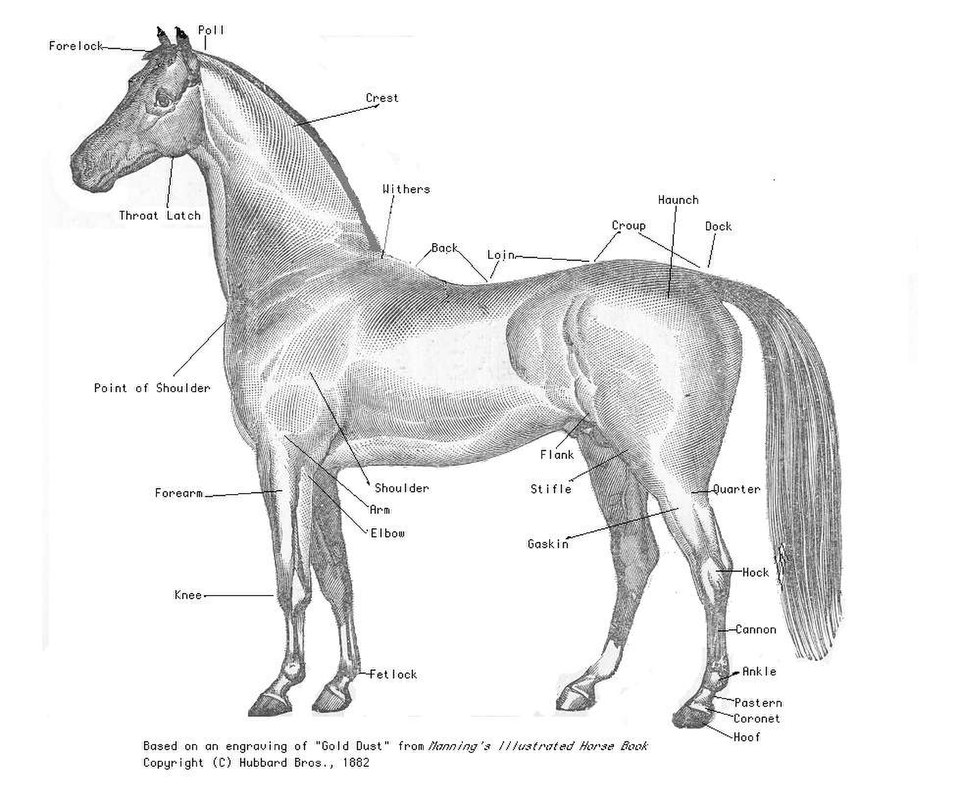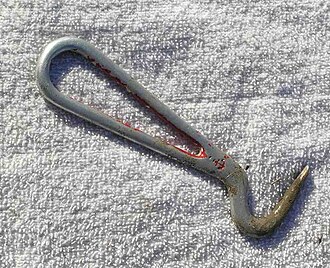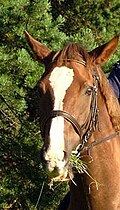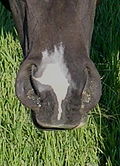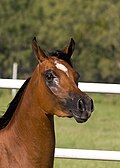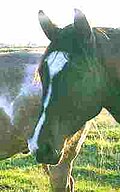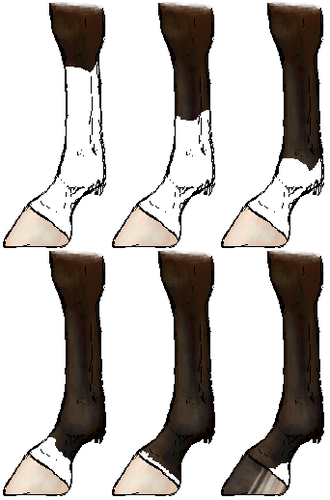Difference between revisions of "AY Honors/Horsemanship - Advanced/Answer Key"
Jomegat bot (talk | contribs) (Bot: Automated import of articles *** existing text overwritten ***) |
Jomegat bot (talk | contribs) m (Delete Honor_Master template from answer key) |
||
| Line 11: | Line 11: | ||
|insignia=Horsemanship_Advanced.png | |insignia=Horsemanship_Advanced.png | ||
}} | }} | ||
| − | {{Honor_Master|honor={{#titleparts:{{PAGENAME}}|1|3}}|master=Sportsman}} | + | <!--{{Honor_Master|honor={{#titleparts:{{PAGENAME}}|1|3}}|master=Sportsman}}--> |
(Instructor Required) | (Instructor Required) | ||
Revision as of 17:13, 23 January 2021
(Instructor Required) Note: All requirements should be completed in a safe environment with a gentle horse.
1
For tips and instruction see Horsemanship.
2
To the parts listed you can add obvious ones like nose, eyes, tail, ears etc to get past 30 parts.
3
Improperly cared-for tack can easily break and injure the rider, the horse, or both. Tack should be inspected every time it is used, and it should be cleaned and put away after every use as well.
Most tack is made from leather, though some is synthetic. Synthetic tack can be thrown into a washing machine, but leather must be meticulously care for. The greatest enemy to leather is mold and mildew. Once mold and mildew have attacked leather, it is nearly impossible to stop it from progressing and destroying the tack. Remove molded or mildewed tack from your other tack, or it will spread. Mold and mildew reproduce by making microscopic pores which become airborne and stick to any surface they come into contact with.
Once molded leather has been taken outside, you can attempt to save it. Start by wiping it down with a disposable wet cloth. Try to get up as much of the mold as you can without smearing it around. Then throw away the damp cloths. Use an old toothbrush to clean out the stitching and crevices. Once it has been thoroughly cleaned, do not put it away with the rest of your tack. Store it in a place by itself, and check it again after a week or two. If the mold has come back, there is probably nothing you can do other than dispose of the tack.
It is obviously better to prevent mold and mildew from getting a start on your tack. To do this, clean your tack after every use. Use a good-quality saddle soap and wipe down all surfaces, including the underside of the saddle (you need to remove the horse's sweat). The purpose of cleaning your tack is to remove salts and dirt. Salts can make leather brittle, while dirt works into the fibers and abrades them, weakening the tack.
Once the tack has been cleaned, store it in a warm, dry place that has plenty of circulation. Do not store tack in a plastic bag, as this effectively prohibits circulation. Many people store their tack in a corner of the barn, but you need to be aware that barns are often havens for mold and mildew.
Tack needs to be conditioned a few times per year after washing, but don't overdo it. If you find that the conditioners are rubbing off onto your clothing, you are definitely over-conditioning the tack. Remove excess conditioning oils with saddle soap and adjust accordingly.
The type of conditioner you use depends on how the leather was tanned. Vegetable-tanned leather should be conditioned with neatsfoot oil. Chrome-tanned leather should be conditioned with Lexol.
4
5
Demonstrate
Demonstrate and explain the listed knots. Knots shown below for reference.
Manger Knot
| Manger Knot |
|---|
|
Use: This knot should be use when tying a horse to a stationary object. Its main advantage is that it can be quickly untied, so if the horse starts to panic it can be quickly freed from the rope before it dangerously tangles itself.
How to tie:
|
Bowline
Adventist Youth Honors Answer Book/Knot/Bowline
6
7
7a
7b
7c
8
9
10
A groom should be especially careful to clean out all crevasses of the hoof, particularly between the frog and the bars, as those areas are most likely to trap rocks or other debris, and also are the most common area to develop thrush. It is best to work the hoof pick from heel to toe, so to avoid accidentally jabbing the horse's leg, the frog of the hoof, or the person using the pick. When picking the feet, the groom stands facing the tail of the horse, then slides his or her hand down the horse's legs. If the horse was not trained to pick up its foot when the groom runs the hand the the fetlock and lifts lightly, most horses will pick up their feet if the tendons behind their cannon bone are squeezed. Some horses, particularly draft breeds, may be trained to pick up their feet when someone pulls on their fetlock hair.
Most horse management guidelines recommend picking the feet daily, and many people pick the feet twice a day, both before and after a ride.
11
12
Horse Colors
Sorrel or Chestnut: A reddish brown horse with reddish, brown or tan mane and tail. Legs are the same color as the body. Their legs may also have white markings. Chestnut runs from very light reddish brown to red or very dark liver color.
Bay: A brown horse with black legs, mane and tail. Body color run from light brown, reddish to very dark brown, but legs, mane and tails are always black (they may also have white markings).
Brown: A very dark brown, almost black coat with lighter brown highlights on the muzzle, the flanks and inside the legs. Mane and tails are always black. They are hard to tell from dark bay.
White: White horses are born white. They have pink skins and usually blue or pink eyes.
Pinto: White plus large patches of black, brown, chestnut or any other colors.
Gray: Born dark with dark skin. Hair becomes whiter with age until pure white. A gray may range from iron gray (nearly black) to dapple gray, white gray or flea-bitten gray (with tiny flecks of black or brown).
Black: Coal black without brown highlights.
Palomino: Golden body color with white mane and tail. Can be a light to very dark gold color.
Face Markings
- Blaze
- A blaze is a broad strip that runs down the horse's face. It does not extend past the eyes, and it is wider than a stripe.
- Stripe
- A stripe is a narrow blaze.
- Snip
- A snip is a marking between the horse's nostrils
- Star
- A star is a marking between the eyes.
- Race
- A race is a crooked or wavy stripe or blaze.
- Baldface
- Baldface is a wide marking on the face that extends past the eyes. Often, a baldface horse will have blue eyes.
Leg Markings
In order of size:
- 1. Stocking
- Stockings extend above the knee or hock and can bleed onto the flank or belly.
- 2. Fetlock or Sock
- White marking that extends over the fetlock, occasionally called a "boot."
- 3. Pastern
- White marking that extends above the top of the hoof, but stops below the fetlock.
- 4. Coronet
- White just above the hoof, around coronary band, usually no more than 1 inch (2.5cm) above the hoof.
- 5. Partial Pastern
- White marking on only one side of pastern.
- 6. Ermine Spots
- Tiny spots of the coat color that show up on a white marking near the coronet band just above the hoof.
- 7. Black Socks or No White Markings
- Some animals have no white on their legs, although some bay animals will have black socks similar to (or in addition to) white ones.
Additional terms used to describe white leg markings include:
- Irregular: A marking within the broad confines of a given height, but with significantly uneven edges. Indicated by the highest point of the white. Most often used to describe certain types of stockings.
- Partial: An irregular marking that only extends up part of the leg to the height indicated, sometimes with the other side of the leg dark. Usually used to describe socks and other short markings.
- "High White:" White stockings that extend above the knee or hock, sometimes extending past the stifle onto the flank or belly, considered characteristic of the sabino color pattern.
13
14
14a
14b
14c
14d
15
References
- Kingsmere Crafts - caring for tack.
